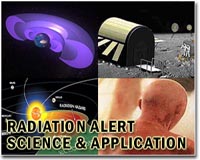 |
Vienna (AFP) March 18, 2011 Radiation levels currently detected in Japan and beyond in the wake of the nuclear crisis after last week's massive earthquake do not pose any harm to human health, an IAEA expert said Friday. "Regular dose information is now being received from 47 Japanese cities," Graham Andrew, scientific and technical advisor to the head of the International Atomic Energy Agency, told a regular daily press briefing here. "Dose rates in Tokyo and other cities remain far from levels which would require action. In other words they are not dangerous to human health," he said. The IAEA has just sent a radiation monitoring team to Japan to help authorities determine whether any dangerous radiation has been released from the stricken Fukushima nuclear plant, 250 kilometres (155 miles) northeast of Tokyo. "First measurements in Tokyo showed no indication of iodine 131 or cesium 137. These are fission products which come from the fuel," Andrew said. The team would now move to the Fukushima region "as soon as possible" to continue monitoring there. The IAEA said important data about radiation levels by a fellow UN agency that monitors for clandestine nuclear tests appeared to back up its assessment that current radiation readings posed no threat to human health. Vienna-based diplomats with access to that data from the Preparatory Commission for the Comprehensive Nuclear-Test-Ban Treaty Organization (CTBTO) said radiation had reached Sacramento in southern California in the US, but first readings were well below levels that would be harmful to health. "I am aware that we have the data, but I haven't studied it and I don't think my colleagues have either," Andrew said. But it appeared to "confirm what I said earlier." After the release of radiation from Fukushima, there have been calls for radioactivity readings from the specialist agency's network to be made available. The CTBTO has calculated the course of the plume of radiation over the Pacific to the United States and other countries. However, the body is normally only allowed to share the data with member states and not directly with the public. Nevertheless, it confirmed in a statement that it would share its monitoring data and analysis reports with the IAEA and the World Health Organisation. The CTBTO uses a global network of hydroacoustic and seismic stations to detect nuclear bomb explosions and its data is also used in tsunami warning systems. It is currently building a global verification system to detect nuclear explosions in an effort to verify a comprehensive ban on nuclear testing. When complete, its 337-facility network of seismic, hydroacoustic and infrasound stations will watch underground, the oceans and the atmosphere, and its radionuclide stations will sniff the air for tell-tale signs of a nuclear explosion. Nearly 270 monitoring stations, of which 63 are radionuclide sensors, are already operational and send data to the International Data Centre in Vienna for processing and analysis. While the system is designed to detect nuclear blasts, it also picks up a vast amount of data that could potentially be used for civil and scientific purposes. Turning to the IAEA's overall assessment of the situation at Fukushima currently, Andrew said it had not worsened "significantly" over the past 24 hours, but remains "very serious." And he refused to speak of "optimism". "At the Fukushima Daiichi nuclear power plant the situation remains very serious. But there has been no signficant worsening since our last briefing," Andrew said, using exactly the same wording as he had done the day before. The current situation at units 1, 2 and 3 of the plant, whose cores had suffered damage from a number of explosions and fires since the devastating earthquake and tsunami nearly a week ago, "appears to be relatively stable," Andrew said. The IAEA is to hold a special meeting of its board of governors on Monday, where its chief Yukiya Amano would brief member states on his trip to quake-hit Japan.
Share This Article With Planet Earth
Related Links Space Technology News - Applications and Research
 US admiral 'optimistic' on Japan nuclear risk
US admiral 'optimistic' on Japan nuclear riskWashington (AFP) March 17, 2011 A top US officer voiced cautious optimism Thursday that a meltdown at Japan's quake-hit nuclear plant could be averted and said the military stood ready to bolster its aid in the crisis. Admiral Robert Willard, who is overseeing American military assistance after Japan's earthquake and tsunami, said 450 radiological and disaster specialists were awaiting orders to deploy as Japanese teams tr ... read more |
|
| The content herein, unless otherwise known to be public domain, are Copyright 1995-2010 - SpaceDaily. AFP and UPI Wire Stories are copyright Agence France-Presse and United Press International. ESA Portal Reports are copyright European Space Agency. All NASA sourced material is public domain. Additional copyrights may apply in whole or part to other bona fide parties. Advertising does not imply endorsement,agreement or approval of any opinions, statements or information provided by SpaceDaily on any Web page published or hosted by SpaceDaily. Privacy Statement |